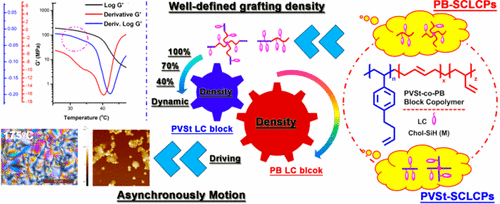当前位置:
X-MOL 学术
›
Macromolecules
›
论文详情
Our official English website, www.x-mol.net, welcomes your feedback! (Note: you will need to create a separate account there.)
Effect of Topology and Composition on Liquid Crystal Order and Self-Assembly Performances Driven by Asynchronously Controlled Grafting Density
Macromolecules ( IF 5.5 ) Pub Date : 2017-10-30 00:00:00 , DOI: 10.1021/acs.macromol.7b01952 Li Han 1 , Hongwei Ma 1 , Siqi Zhu 1 , Pibo Liu 1 , Heyu Shen 1 , Lincan Yang 1 , Rui Tan 1 , Wei Huang 1 , Yang Li 1
Macromolecules ( IF 5.5 ) Pub Date : 2017-10-30 00:00:00 , DOI: 10.1021/acs.macromol.7b01952 Li Han 1 , Hongwei Ma 1 , Siqi Zhu 1 , Pibo Liu 1 , Heyu Shen 1 , Lincan Yang 1 , Rui Tan 1 , Wei Huang 1 , Yang Li 1
Affiliation

|
A series of thermo-tunable liquid crystal block copolymers (LCBCs) with well-designed architectures were successfully synthesized. Linear/star poly[4-(4-vinylphenyl)-1-butene]-block-polybutadiene (PVSt-co-PB) moieties were obtained using living anionic copolymerization of 4-(4-vinylphenyl)-1-butene with butadiene, and topological [PVSt-co-PB]-LCBCs were generated through the adherence of mesogenic moiety via facile hydrosilylation. The PVSt LC block had well-defined grafting densities of approximately 100%, 70%, and 40%, whereas the PB LC block had an asynchronously tunable grafting density. This work included comprehensive studies on their self-assembly and yielded some interesting results. The influences of topologies and compositions on the phase transition behaviors and polarized optical performances of the resulting LCBCs that were driven by asynchronously controlled grafting density were carefully illustrated. The LCBCs with controlled molecular weight (MW) and narrow PDI showed wider LC phase ranges (ΔT) and a high tunability was added into the construction to aid thermos-responsive devices. The wide ΔT and high thermo-stability were demonstrated to be complementary between two LC blocks. However, the response-time and aggregation morphology in POM showed close similarity to LC blocks and showed a gradient in temperature-dependent changes with the PB LC block at a lower temperature and the PVSt LC block at a higher temperature. It is common for LC texture to change with varying temperature, whereas the gradient switching process was unique to LC blocks, which was further confirmed by temperature-dependent WAXD. In particular, the structural reorganization was determined to be driven by asynchronous grafting density by measuring the temperature-variation AFM, in that the asynchronous-tunable motion between LC blocks facilitates small phase separation.
中文翻译:

拓扑和组成对异步控制接枝密度驱动的液晶有序和自组装性能的影响
成功合成了一系列具有精心设计的结构的热可调液晶嵌段共聚物(LCBC)。线性/星形聚[4-(4-乙烯基苯基)-1-丁烯]-嵌段-聚丁二烯(PVSt- co -PB)部分是使用4-(4-乙烯基苯基)-1-丁烯与丁二烯的活性阴离子共聚得到的,和拓扑[PVSt- co-PB] -LCBCs通过介导的易氢化硅烷化作用介晶基团的粘附而产生。PVSt LC嵌段具有明确定义的接枝密度,大约为100%,70%和40%,而PB LC嵌段具有异步可调的接枝密度。这项工作包括对它们的自组装的全面研究,并产生了一些有趣的结果。仔细说明了拓扑和组成对由异步控制的接枝密度驱动的所得LCBC的相变行为和偏振光学性能的影响。具有受控分子量(MW)和窄PDI的LCBC显示出更宽的LC相范围(ΔT),并且向该结构中添加了高可调性,以辅助热敏器件。宽ΔT两个LC嵌段之间的互补性和高热稳定性被证明是相辅相成的。但是,POM中的响应时间和聚集形态显示出与LC嵌段非常相似,并且在较低温度下具有PB LC嵌段而在较高温度下具有PVSt LC嵌段的温度依赖性变化呈梯度变化。LC纹理随温度变化而变化是很常见的,而梯度转换过程是LC块所独有的,这一点已由温度依赖性WAXD进一步证实。特别地,通过测量温度变化AFM,确定结构重组是由异步接枝密度驱动的,因为LC块之间的异步可调运动有助于小的相分离。
更新日期:2017-10-30
中文翻译:

拓扑和组成对异步控制接枝密度驱动的液晶有序和自组装性能的影响
成功合成了一系列具有精心设计的结构的热可调液晶嵌段共聚物(LCBC)。线性/星形聚[4-(4-乙烯基苯基)-1-丁烯]-嵌段-聚丁二烯(PVSt- co -PB)部分是使用4-(4-乙烯基苯基)-1-丁烯与丁二烯的活性阴离子共聚得到的,和拓扑[PVSt- co-PB] -LCBCs通过介导的易氢化硅烷化作用介晶基团的粘附而产生。PVSt LC嵌段具有明确定义的接枝密度,大约为100%,70%和40%,而PB LC嵌段具有异步可调的接枝密度。这项工作包括对它们的自组装的全面研究,并产生了一些有趣的结果。仔细说明了拓扑和组成对由异步控制的接枝密度驱动的所得LCBC的相变行为和偏振光学性能的影响。具有受控分子量(MW)和窄PDI的LCBC显示出更宽的LC相范围(ΔT),并且向该结构中添加了高可调性,以辅助热敏器件。宽ΔT两个LC嵌段之间的互补性和高热稳定性被证明是相辅相成的。但是,POM中的响应时间和聚集形态显示出与LC嵌段非常相似,并且在较低温度下具有PB LC嵌段而在较高温度下具有PVSt LC嵌段的温度依赖性变化呈梯度变化。LC纹理随温度变化而变化是很常见的,而梯度转换过程是LC块所独有的,这一点已由温度依赖性WAXD进一步证实。特别地,通过测量温度变化AFM,确定结构重组是由异步接枝密度驱动的,因为LC块之间的异步可调运动有助于小的相分离。



























 京公网安备 11010802027423号
京公网安备 11010802027423号